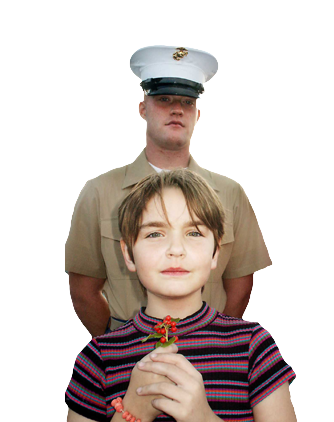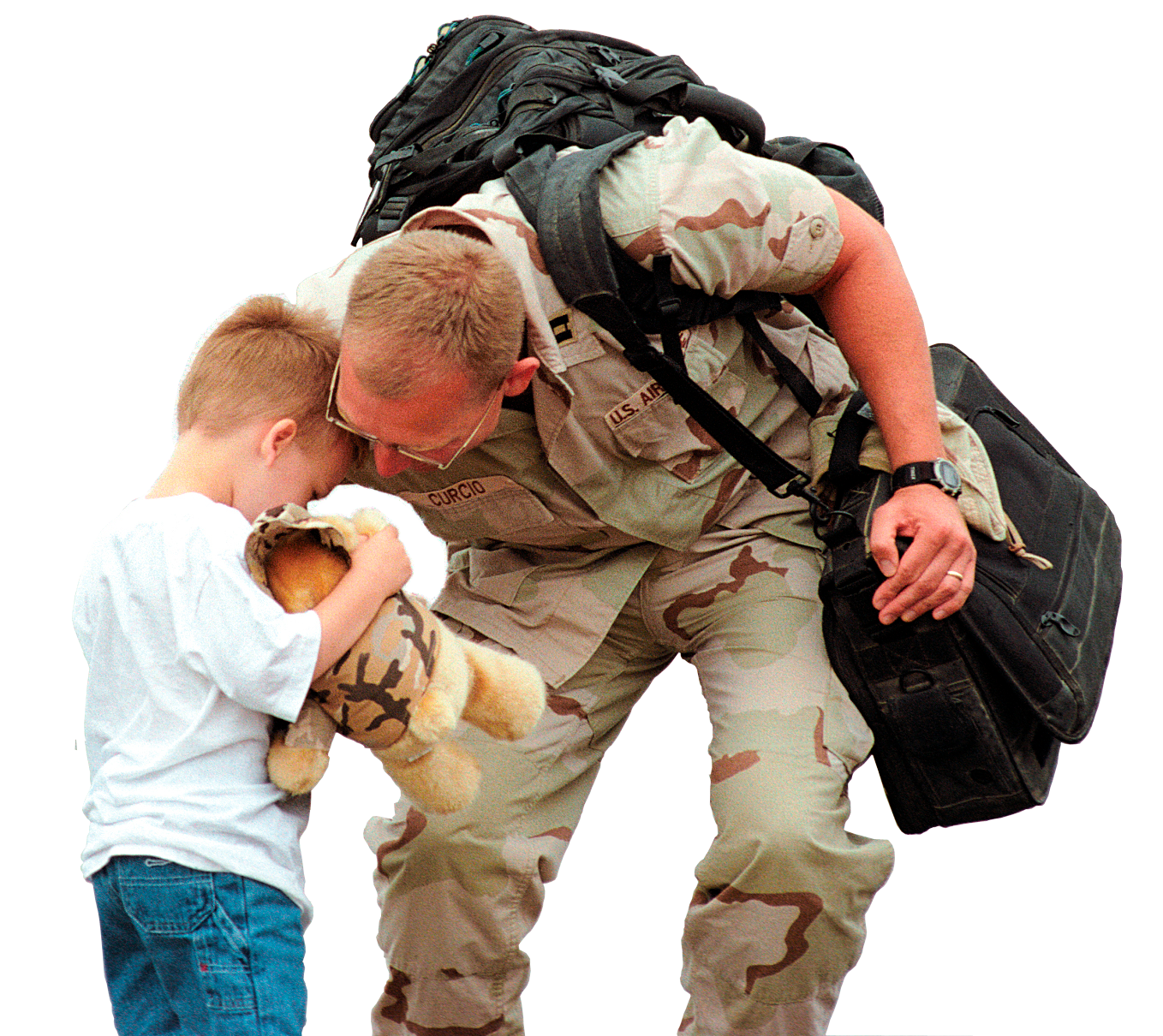Meet Your Military
- Details
- Hits: 8988
OKINAWA, Japan, Aug. 6, 2015 – Kadena Air Base is home to an array of aircraft designed to perform a variety of missions -- from cargo transportation to air superiority -- but none of those missions are accomplished without the support of ground crew. Air Force Staff Sgt. Thomas Lewellen, an aircraft fuel systems craftsman with 18th Component Maintenance Squadron, and Air Force Senior Airman Elizabeth Melton, a fuel systems journeyman with 18th CMS, inspect an external fuel tank at Kadena Air Base, Japan, Aug. 4, 2015. Lewellen is Melton’s supervisor. U.S. Air Force photo by Airman 1st Class Lynette Rolen
Air Force Staff Sgt. Thomas Lewellen, an aircraft fuel systems craftsman with 18th Component Maintenance Squadron, and Air Force Senior Airman Elizabeth Melton, a fuel systems journeyman with 18th CMS, inspect an external fuel tank at Kadena Air Base, Japan, Aug. 4, 2015. Lewellen is Melton’s supervisor. U.S. Air Force photo by Airman 1st Class Lynette Rolen
That support includes airmen from the 18th Component Maintenance Squadron, like Air Force Staff Sgt. Thomas Lewellen. He and his fellow fuel systems experts help ensure the jets take to the sky. "To work on an aircraft, especially an aircraft that you know is going to do a mission … and then see a pilot instantly step into it and take off -- to make the mission happen, that is absolutely the best," Lewellen said.
Fast Learner Lewellen has worked on aircraft throughout his nine years in the Air Force -- mostly F-15 Eagles, but plenty of others, too. When new aircraft were added to his shop, his superiors noticed how quickly Lewellen adapted. "Within one day of a training course, he was already out on a KC-135 [Stratotanker] and was troubleshooting," said Tech. Sgt. Daniel Little, an assistant section chief at the 18th CMS aircraft fuel systems repair facility, who said he has known Lewellen for just over one year. "He’s the tip of the spear." Noncommissioned officers, though, aren't just charged with mastering their technical jobs. As leaders, it’s imperative they impart their knowledge to the next generation. That's a skill in which Lewellen takes pride. "I’m a firm believer in actually leading, showing them how to do it, leading them through it, and then letting them show you what they have done the next time the task needs to happen," Lewellen said. "Just telling them to do something would be supervising or managing -- not leading."
Read more: Meet Your Military: Fuels Airman Knows How to Support Jets, Lead People
- Details
- Hits: 3262
 Army Pfc. Gustavo Moreno celebrates after his last in a series of radiation treatments for T-cell Acute Lymphoblastic Lymphoma at San Antonio Military Medical Center, Fort Sam Houston, Texas, July 20, 2015. Moreno was diagnosed with cancer in January 2014. U.S. Army photo by Robert Whetstone JOINT BASE SAN ANTONIO-FORT SAM HOUSTON, Texas, Aug. 5, 2015 – When Army Pfc. Gustavo Moreno recited the oath of enlistment, he knew he was charged to defend his country against all enemies. What he didn't know is that shortly after completing basic combat training, he'd be fighting a different enemy altogether.
Army Pfc. Gustavo Moreno celebrates after his last in a series of radiation treatments for T-cell Acute Lymphoblastic Lymphoma at San Antonio Military Medical Center, Fort Sam Houston, Texas, July 20, 2015. Moreno was diagnosed with cancer in January 2014. U.S. Army photo by Robert Whetstone JOINT BASE SAN ANTONIO-FORT SAM HOUSTON, Texas, Aug. 5, 2015 – When Army Pfc. Gustavo Moreno recited the oath of enlistment, he knew he was charged to defend his country against all enemies. What he didn't know is that shortly after completing basic combat training, he'd be fighting a different enemy altogether.
Born and raised in San Antonio, Texas, Moreno, a self-confessed basketball junkie and Spurs fanatic, found himself in a very grown-up situation during his senior year of high school: He was going to be a father. Moreno said he knew he had to do something as soon as possible. He had to step up and be there for his then-girlfriend and now-wife, Valerie Hernandez, and their daughter, Avalee. While Hernandez remained home, Moreno went to Fort Sill, Oklahoma, for basic training. “I went in October 2013 and didn’t come back till December,” Moreno said. After a brief trip home following basic training, Moreno returned to Fort Sill in January 2014 for advanced individual training.
Read more: Meet Your Military: Seriously Ill Soldier Vowed to Never Quit
- Details
- Hits: 7717
COAST GUARD AIR STATION North Bend, Oregon., Aug. 4, 2015 – An Olympic-length triathlon swim is just under a mile -- 0.9 miles to be exact. A Coast Guard rescue swimmer completed a triathlon swim of a different nature and saved four lives July 21, 2015.
Coast Guard Petty Officer 2nd Class Darren Harrity, an aviation survival technician assigned here, swam a total of 0.99 miles, half of which was done while body towing grown adults to shore after their 52-foot commercial fishing vessel ran aground near Cape Blanco, Oregon. Harrity returned to the 57-degree water four times and pulled each fisherman about 250 yards to shore, where they were met by emergency medical services. Each of the fishermen were the same size or larger than the 6-foot, 175-pound Harrity.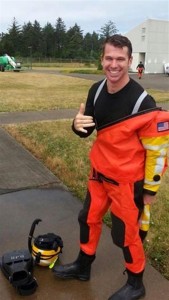 Coast Guard Petty Officer 2nd Class Darren Harrity, an aviation survival technician assigned to Coast Guard Air Station North Bend, rescued four people from a fishing vessel that ran aground in the early morning hours of July 21, 2015. U.S. Coast Guard photo “The rescue was definitely one of the most challenging I have ever done, and it was the first one for me at night,” said Harrity, a 27-year-old native of Jupiter, Florida. “My fellow aircrew members shined a spotlight down in my general direction, and the mast light from the fishing vessel lit up the life raft quite well. I also used the headlights from the emergency medical vehicles on shore to guide me into the beach.” After being dispatched by watchstanders at Coast Guard Sector North Bend, Harrity and his fellow aircrew members arrived on scene at 2:49 a.m. The call for help was received at 1:40 a.m., so when Harrity arrived at the side of their life raft, the fisherman had been floating alone in the Pacific Ocean for more than an hour.
Coast Guard Petty Officer 2nd Class Darren Harrity, an aviation survival technician assigned to Coast Guard Air Station North Bend, rescued four people from a fishing vessel that ran aground in the early morning hours of July 21, 2015. U.S. Coast Guard photo “The rescue was definitely one of the most challenging I have ever done, and it was the first one for me at night,” said Harrity, a 27-year-old native of Jupiter, Florida. “My fellow aircrew members shined a spotlight down in my general direction, and the mast light from the fishing vessel lit up the life raft quite well. I also used the headlights from the emergency medical vehicles on shore to guide me into the beach.” After being dispatched by watchstanders at Coast Guard Sector North Bend, Harrity and his fellow aircrew members arrived on scene at 2:49 a.m. The call for help was received at 1:40 a.m., so when Harrity arrived at the side of their life raft, the fisherman had been floating alone in the Pacific Ocean for more than an hour.
Terrain Made Rescue a Challenge Harrity knew before leaving the helicopter that he was in for a long and taxing morning. “The flight down from North Bend was the most stressful event of the whole rescue,” said Harrity. “We flew into thick fog and strong wind, but because of the skill of the pilots I knew it would be okay. The knowledge of what was on the other end of our flight pushed us to keep going.” The air crew discussed the rescue plan and the weather conditions on the way from North Bend to Cape Blanco. “We knew going in that the wind and the severe downdrafts coming off the cliffs of Cape Blanco were going to be beyond the helicopter’s limitations and it would be too dangerous to hover and conduct hoisting operations,” said Harrity.
Read more: Meet Your Military: Coast Guardsman Swims to Save Lives
- Details
- Hits: 8292
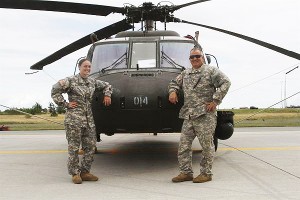 New York Army National Guard members Warrant Officer Meghan Polis, left, and Chief Warrant Officer 3 Stephen Polis -- a daughter and dad flying duo who are both assigned to Company B 3rd Battalion 142nd Assault Helicopter Battalion -- pose in front of a UH-60 Black Hawk helicopter at Fort Drum, New York, July 22, 2015. U.S. Army photo by Sgt. Jonathan MonfilettoFORT DRUM, N.Y., July 30, 2015 – Army Warrant Officer Meghan Polis, a UH-60 Black Hawk helicopter pilot in the New York National Guard, doesn’t remember it but she logged her first three hours of helicopter flight time when she was just 3 months old.
New York Army National Guard members Warrant Officer Meghan Polis, left, and Chief Warrant Officer 3 Stephen Polis -- a daughter and dad flying duo who are both assigned to Company B 3rd Battalion 142nd Assault Helicopter Battalion -- pose in front of a UH-60 Black Hawk helicopter at Fort Drum, New York, July 22, 2015. U.S. Army photo by Sgt. Jonathan MonfilettoFORT DRUM, N.Y., July 30, 2015 – Army Warrant Officer Meghan Polis, a UH-60 Black Hawk helicopter pilot in the New York National Guard, doesn’t remember it but she logged her first three hours of helicopter flight time when she was just 3 months old.
Her father -- New York Army National Guard Chief Warrant Officer 3 Stephen Polis -- and her mother were going to a barbecue in Albany. They lived on Long Island and they decided to make the trip north by air instead of driving. The flight school Stephen Polis worked for at the time as an instructor pilot allowed him to borrow a two-seat helicopter for the day. His wife held little Meghan to her chest and put cotton balls in the baby’s ears. And away the family went.
Sharing a Love of Flying Since then, dad and daughter, both from East Patchogue, New York, have shared a love of flying that extends into their military careers. On July 22, the two Army Guard aviators made their first flight together as pilots, during the 42nd Aviation Brigade’s annual training here. The two are UH-60 Black Hawk helicopter pilots assigned to Company B, 3rd Battalion, 142nd Assault Helicopter Battalion, headquartered in Ronkonkoma, New York. They flew as pilot in command -- dad -- and pilot -- daughter -- on a morale flight for the mechanics, fuelers, supply people and other support personnel who keep the pilots of the 3-142nd in the air. The aircraft, Stephen said, was the same one he flew in 2008-2009 when the unit deployed to Iraq.
Read more: Meet Your Military: Father, Daughter Helicopter Pilots Fly Together
- Details
- Hits: 4465
After almost three years of inactivity, the Air Force recertified the Viper Demo Team and chose Baker to be its sole pilot. "Craig always wanted to be a fighter pilot," said Lindsey Baker, Baker's wife of 10 years. "That, coupled with his desire to serve our country, drives what he does. He puts his all into everything that he is passionate about." From a young age, the Air Force Academy graduate said, he had an itch for the thrill to fly. 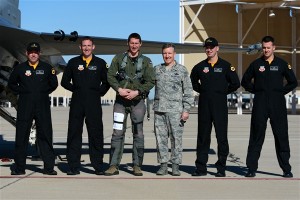 Air Force Capt. Craig “Rocket” Baker, F-16 Viper Demo Team pilot, center left, stands for a photo with team members and Gen. Hawk Carlisle, center right, commander of Air Combat Command, during the Heritage Flight Certification and Training Course at Davis-Monthan Air Force Base, Ariz., Feb. 28, 2015. U.S. Air Force photo by Senior Airman Jensen Stidham"It's what I always wanted to do, and I've been fortunate enough along the way to have family from when I was a kid all the way through my Air Force career, support me along the way to allow what was a dream to become a reality," Baker said. Through the years, the Gray's Creek, North Carolina, native said, he sought the best way to become an Air Force pilot. "I started asking questions, because I really wanted to fly," he said. "Most of the pilot slots were given to the Air Force Academy, so at that point I set my sights on going there."
Air Force Capt. Craig “Rocket” Baker, F-16 Viper Demo Team pilot, center left, stands for a photo with team members and Gen. Hawk Carlisle, center right, commander of Air Combat Command, during the Heritage Flight Certification and Training Course at Davis-Monthan Air Force Base, Ariz., Feb. 28, 2015. U.S. Air Force photo by Senior Airman Jensen Stidham"It's what I always wanted to do, and I've been fortunate enough along the way to have family from when I was a kid all the way through my Air Force career, support me along the way to allow what was a dream to become a reality," Baker said. Through the years, the Gray's Creek, North Carolina, native said, he sought the best way to become an Air Force pilot. "I started asking questions, because I really wanted to fly," he said. "Most of the pilot slots were given to the Air Force Academy, so at that point I set my sights on going there."
Read more: Meet Your Military: Demo Team Pilot 'Rockets' to New Heights




